First a brief lesson about rotating tires:
“Rotating tires” is part of the parlance of automotive speak that does not lend itself to self-explanation for the unfamiliar. First of all, just to make sure everybody is on the same page, the tire is the rubber part (but there are actually other materials inside them like steel or nylon), and the wheel is the metal part. To rotate tires is simply to move the tire-wheel assemblies to different positions so that they wear down more evenly. (I will say “wheel” to mean a wheel-tire assembly in this article and sometimes elsewhere; if I say “tires” in the context of “rotating tires” it also means wheel-tire assemblies. To rotate tires and only tires would be a big waste of time because you would have to dismount the tires from the wheels, remount them and balance them.) There used to be somewhat complicated schemes for rotation, like moving the front wheels/tires to the rear on the same side and moving the rear tires to the front on the opposite sides. But these days some tires (“directional” tires) are designated to roll forward in a specific direction, which means that they should only ever be on one side of the car (unless you dismounted them from the wheel and flipped them over, and that would be very unusual). So I have only ever done tire rotations in which the front wheels are swapped with the back wheels, always on the same side. (Some tires are also asymmetric in that there is a designated inside and outside, i.e. the outside sidewall is the only one you can really see unless you’re under the car.)
Why do front tires on the front and back wear down differently? After all, that’s the reason for all this tire-rotating nonsense. It’s simple: The front tires do practically all of the work (on a typical front-wheel drive car). They definitely do all of the positive acceleration (my term for when speed is increasing whether forward or backward, but obviously we’re mostly talking forward here). They also do most of the braking (which is also acceleration for science and engineering nerds). They also do most of the turning, and they do so in such a way that the tire actually leans over a bit so different parts of the tire are being worn.
So your front tires wear out faster than your rear tires. But why is that a big deal? Couldn’t you just let them wear out faster, and then replace the front tires when they get worn out and save the rear tires until later?
My answer: Yes… Maybe… Sort of…
Industry practice when replacing only two tires is to always put the new tires in the rear. The reason for this, as I understand it, is to have the best traction in the rear. In the event of an accident when emergency braking is applied, it is better to under-steer than over-steer (aka fish-tail). If your front tires had more traction than your rear tires, you would be able to swerve your front end away from peril, but your car would still have momentum in the same direction without as much friction force at the tail end of the car to divert that momentum to a different direction. So even with good tire in front you would still lose control after your initial steering maneuver. With good tires in the rear, you might not be able to steer as hard or as quickly as you try, but with Anti-Lock Brakes you would still have control, even if you couldn’t turn as fast as you wanted to, and you would be less likely to lose control of the rear end of the car (fish-tail).
So, let’s say you rotate your tires every time your mechanic recommends it. Your tires wear out evenly, so all 4 tires are at the minimum tread at the same time. You replace all 4 tires at once, and you’re good to go. Nothing ambiguous about that scenario.
But let’s say there’s a wrench in the works. Let’s say you didn’t get your tires rotated, and now your mechanic says that your front tires are worn significantly more than your rear tires, so you aren’t allowed to rotate them because the better tires need to be in the rear. (When I recommend a tire rotation it’s only a few 1/32’s of an inch difference in tread depth from front to back. Now that I have my own shop I think I’m going to start measuring tread in millimeters instead. Everything should go metric!) Okay, so you’re too late to rotate your tires… now what?
Well, just keep driving until it’s time to replace the front tires. (But if we’re talking about an all-wheel drive car like a Subaru that would tear your transmission apart. They’re great for driving on snow and ice, but you’ve got to keep all your tires’ treads matching very closely. Subaru even has a specification for the maximum difference in tire circumferences– it’s just a few millimeters… I don’t recall exactly. Don’t miss those tire rotations!) When you get new tires your mechanic will put them in the back and move the older rear tires up to the front.
So now what? Are those older front tires anywhere close to having the same tread as the brand new ones? Maybe. Or maybe not. Do your tires get rotated now? Maybe. But why would you put the tires with less wear (the brand new ones) on the back when you’re just going to rotate them to the front at the next service. This is part of what confuses me.
Also, is it better to replace all 4 tires at the same time. From a customer’s perspective, why bother with all those tire rotations? Doesn’t it seem like it would be safer to have 2 half-worn tires in the rear before you get 2 new tires rather than having all 4 tires at the absolute minimum tread? This is the other part that confuses me.
Anyway, now on to the peculiar aspects of Think wheels and tires:
I have noticed when removing Think wheels (whether for tire rotation or for brake inspection or whatever), that water will often be trapped in a cavity between the wheel and the brake disc or drum. This seems like it can’t be good. I can’t explain how the water gets into those cavities, but it stays there and presumably continues to cause corrosion well after exterior conditions are dry.
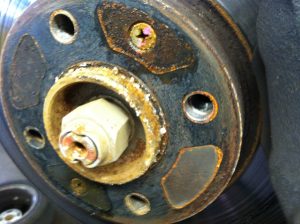
I can’t recall having ever seen this with other wheels– yes, they get corroded, but they don’t hold water. Other wheels do not form these mostly sealed cavities against the brakes– they have channels that keep them open to the outside.
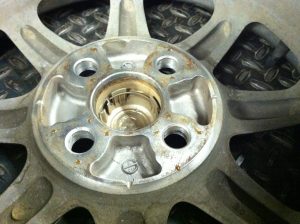
So for most Thinks that I have removed wheels from, I have cut some drainage channels into the wheels to mimic the design of other wheels. I discussed this change with my former boss Jim at Hawthorne Auto Clinic, and we decided that it was beneficial and we couldn’t think of any real drawbacks. I simply use a cutting wheel on a Dremel to cut a path from the corners of each cavity to the outside edge of the wheel’s mating surface.
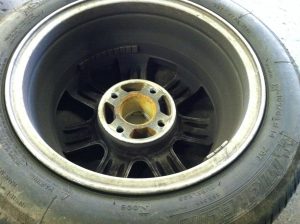

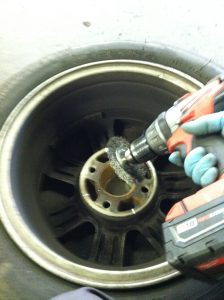
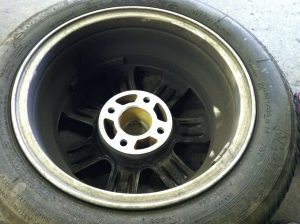
Another note about Think tire rotations:
If you keep your tires at the recommended pressures, 36psi in front and 43psi in back, then you will probably get a Tire Pressure Monitor System warning light on the center console. This is because your formerly rear tires know that they’re supposed to be at 43psi, and they have to be told that they should be set to a lower pressure now (and your formerly front tires need to be told that they should stay at a high pressure). The TPMS light on the center console (to the left of the PRNDE) is yellow with an exclamation point and the cross-section of a tire.
Here’s how you get that light to go out: When you have made sure all your tires are set to the appropriate pressure, remove the cover from the passenger dash tray to expose the fuse box. With the car running, press and hold the TPMS reset button to the left of the fuses until you hear a beep/tone/chime and the TPMS light blinks rapidly. Now you have to drive the car for awhile. The user manual has some specification, like 15 miles at 30 mph or more, but it’s really not all that far. My experience has been around 2 miles or 5 minutes, but I think it depends on your time above a certain speed. You’ll know that the system has relearned its set points when it beeps again and the TPMS light goes out. If you turn the key off before it finishes learning, you’ll have to restart the process.
There are a few reasons the TPMS light might come on that aren’t related to tire pressure: Someone could have broken a sensor when they were dismounting/mounting a tire. (They’re attached to the inside of the valve stem; it’s an easy mistake to make– I’ve broken my share of TPMS sensors.) Also, a battery could have died; the sensors run on batteries just like wrist watches.
In these cases you need to go to a tire shop to get the sensor replaced. They will need to know that Thinks use the same TPMS sensor as is used in the 2002-2003 Chrysler Town & Country (I think, it’s been awhile since I’ve done one!). It’s made by Schrader. They have a tool that they can use to go around to each tire and communicate with each individual sensor to find out which one is faulty.